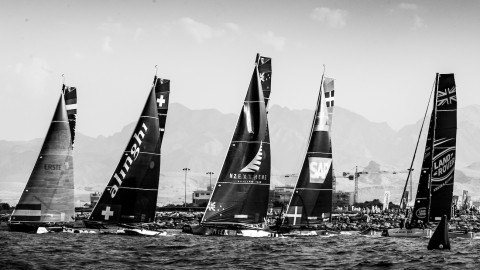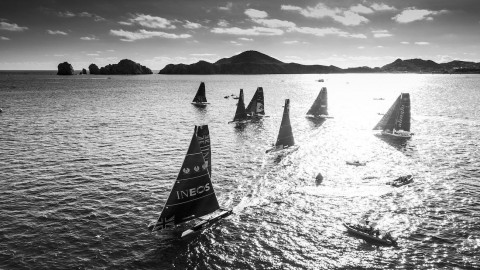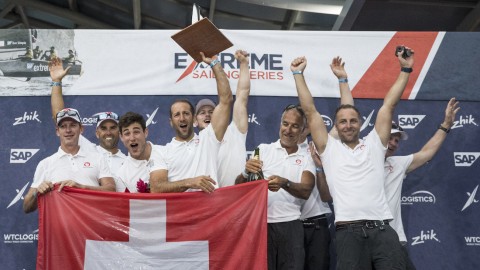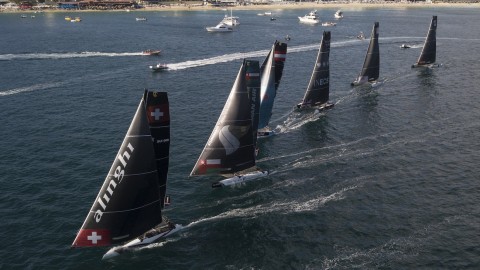Setting the boundaries
The Extreme Sailing Series™ presents some of the most exciting sailing on the planet – The regattas are spectacular and the racing at times can seem on the fine edge between thrilling and downright dangerous to the untrained observer.
Tuesday 19th May 2015

The Extreme Sailing Series™ presents some of the most exciting sailing on the planet – super-fast catamarans racing each other in a confined and restricted space, with the crowd watching from the beach or the harbour wall.
The regattas are spectacular, even breathtaking and the racing at times can seem on the fine edge between thrilling and downright dangerous to the untrained observer. It is the job of the Race Director and his team, plus the skippers of the Extreme 40s themselves, to ensure that that line does not get crossed and races are not dominated by collisions that could injure sailors or multiple capsizes leaving crews struggling in the water, as Ed Gorman writes.
The man who carries the most responsibility in this respect is Race Director Phil Lawrence, an experienced pro sailor. He views his role as trying to balance the competing interests of the requirement for a spectacular show and the need to ensure that everyone gets back to the dock in one piece.
Lawrence, 60, has been in the role for four years and like everyone else who works on the Series, loves the challenge it offers. “The concept is that we are racing high speed catamarans in a confined space,” he said. “The original idea was to have eight boats doing this – and that is still the ideal number - but at times we have had up to 12. As such, collisions and the occasional capsize are part of the game – they are inevitable.
“What I am trying to do is manage that situation as much as possible so that they don’t happen very often and, if they do happen, we have mitigated the impact of them.”
Lawrence has a range of tools at his fingertips to keep the spectacle within bounds. Course-setting is the first key variable and he works to a series of golden rules that are observed at every Act. For example Lawrence and his team would never set a course where the catamarans would start on a fast reach and then immediately turn upwind.
As Lawrence says, this would be to design a crash “into” the course. “As the crews turn to windward, it would be like slamming on your brakes in the outside lane of a motorway,” he said. “Instead, if we have a fast reach to start then we will always bear away onto a run which means the crews have got plenty of exit room and don’t all have to pile into the back of each other.”
The wind and sea-state are other key variables and as the former gets stronger and the latter rougher, Lawrence can make changes to the course and format to ensure the racing remains safe. He has a chain of calls he can make starting with requiring the crews to wear crash helmets and personal buoyancy. Then he can issue a directive that invited guests, sailing as passive crew members, are taken off the boats. After that he can ask the skippers to put a reef in the mainsail, which reduces its size. At the same time he can tinker with the course, for example making the start line longer, the downwind gates wider or changing the angle of the course to the wind to help spread the boats out.
When it becomes really breezy Lawrence can split the fleet into groups of four to reduce the element of chaos and on rare occasions he can cancel racing altogether – something that has only happened twice in the Series’ nine-year history – once in Nice, France in 2012 and in Cowes, UK in 2011 when gusts in excess of 30 knots quashed proceedings at both venues. Of course most of the sailors love rough conditions in these exciting boats and the rougher it gets the more fun they have. But Lawrence said he has had to sit down with them only once in four years to remind them, as he put it, that the Extreme Sailing Series is not a “contact sport.”
“They are highly professional sailors – they are super-competitive animals,” he said. “They want to win and they work very hard to win. One of the key points about the Series is that if you did not have these super-skillful sailors you wouldn’t be able to do this because you wouldn’t have a fleet left at the end of the rough days. The skill levels are very, very high – that’s not flattering them – that’s a fact.”
Working alongside Lawrence is a team of safety officers both on shore and on the water who ensure that when a capsize or a collision happens or a sailor falls overboard, there are people with the equipment and skills there to help. Ian Fiddaman has been the safety RIB driver at the Extreme Sailing Series since the event began nine years ago. A former lifeboat-man and community responder in the ambulance service, Fiddaman is superbly qualified for the role.
He is in constant contact with Lawrence as they continually adjust the course and watch for changes in sea state or wind conditions that could adversely impact the racing. Fiddaman’s RIB carries a full medical kit – there is particular concern about possible head and spinal injuries as result of collisions – and his crew, Neil Nelhams, is an osteopath with long experience in back injury. There is also an ambulance attending on shore at all times when the boats are racing.
“It’s not dangerous because it is properly managed,” says Fiddaman who, like Lawrence, believes that the skill of the sailors is critical to a safe outcome. “At the end of the day it is called the Extreme Sailing Series but we have very few accidents and I believe that is because we have such good sailors on the boats.”
He makes a very interesting point about the difference between ambulance work and his role in the Series. “The difference is that when you train for ambulance responding they tell you that you will have had no effect on the accident happening. You are simply there to do good once it has happened. The challenge with the Extreme Sailing Series – and this is from a personal mindset point of view – is that we have had an input into any accident or collision happening through course-setting or other decisions we have made, and that’s why we try to do a lot of work to prevent them.”
One of the super-skilled sailors mentioned by Fiddaman is two-time Extreme Sailing Series champion Paul Campbell-James. He loves it when the breeze is up and he and his crew have to start fighting their boat to get it round the course. “I wouldn’t say that it doesn’t become fun when it is frightening – if anything it is quite the opposite,” he observes.
Campbell-James says the single most hazardous manoeuvre on the Extreme 40s is the phase when the boats switch from going upwind to downwind, bearing away and accelerating as they do so. At this point in breezy conditions a capsize is always a possibility and slick crew work and being properly prepared are key to success.
“You’ve got to have everything set up before you go for it, you’ve got to be going reasonably fast so the boat turns quickly and you’ve got to have a long enough mainsheet that is eased enough so the boat loses enough power through the turn,” he says.
If the boat does capsize, Campbell-James has learnt that the first rule is to hang onto the hull at all costs and thus avoid being flung into the water when a sailor could hit the rig or become tangled in lines. “Normally when a boat goes over, it stays on its side for a minute and that gives everyone enough time to get out of the way if it is going to go upside-down. The first concern is holding on and making sure you don’t fall. The second is making sure you are out of the way if it does invert,” he says.
Racing in a competitive fleet in close company with other boats takes a lot of nerve but Campbell-James says many potentially big collisions can be avoided by keeping your eyes open and thinking ahead. “You’ve got to be pretty well-prepared and see things quite heavily in advance,” he summarised.
The last word goes to Lawrence who believes the mindset amongst Extreme Sailing Series race officers, shore crew and sailors is about right when it comes to safety. “Of course it is stressful at times and there is a lot of responsibility involved and you have to make sure you get it right and you learn something every time. But we are a professional circuit and we doing this on a professional basis and we spend a lot of time making sure we have everything we need in place” he said.




